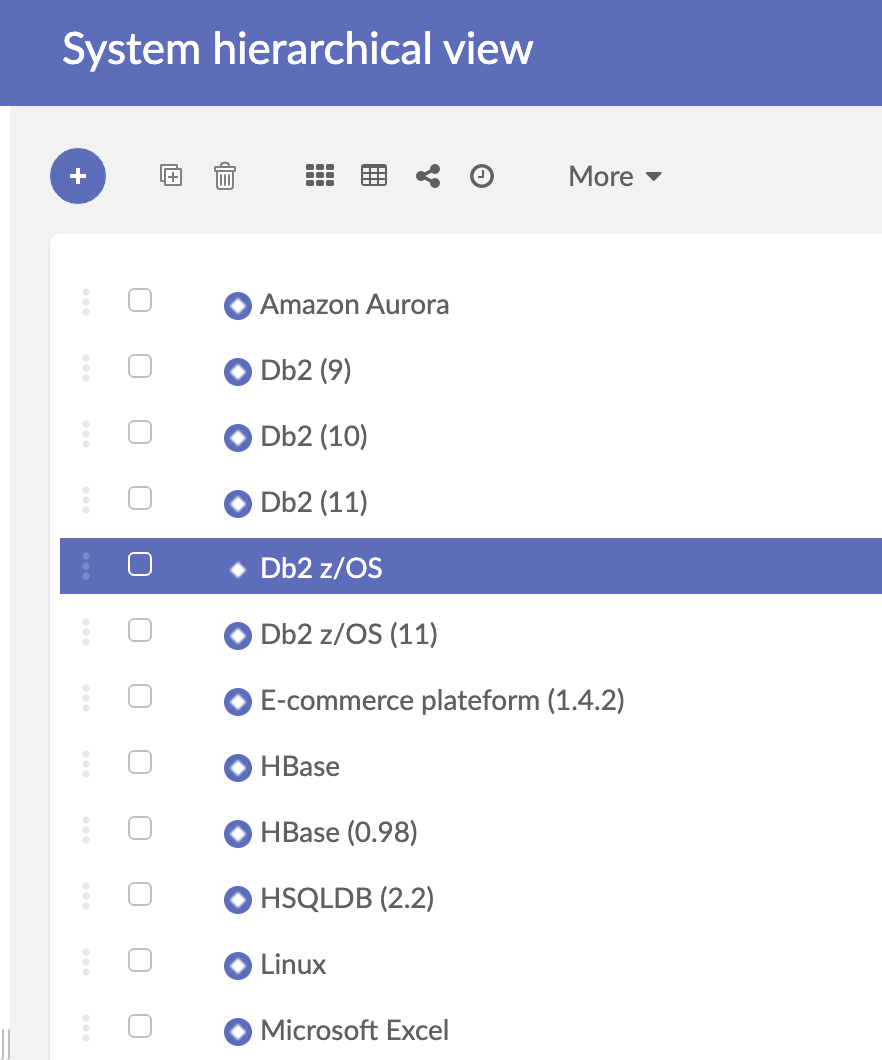Create a system
In the Technology menu of the main control panel, select ‘Systems’ to access the system screen.
A main page listing all existing systems will be displayed.
If you click on Hierarchy view, you will see a few built-in systems, needed for harvesting and provisioning features.
- TIBCO Data Virtualization
- IBM DB2 (several versions)
- HBase (several versions)
- HSQLDB
- Microsoft Excel
- Microsoft SQL Server (several versions)
- Oracle MySQL (several versions)
- Oracle Database (several versions)
- PostgreSQL (several versions)

These built-ins systems cannot be deleted as are needed by harvesting & provisioning features. You are able to create other systems and system types, accordingly to your needs.
Create a new system
After clicking on the “+” button on the top left corner, you have access to the creation screen. In this screen you have to fill system information.
| Field | Description | Technical name |
|---|---|---|
| Identifier |
This field is mandatory. Primary key of the object, it uniquely identify the object of this kind in TIBCO Cloud™ Metadata. The identifier is automatically generated and cannot be modified. |
id |
| Label |
This field is mandatory. A word of set of word which will be used in TIBCO Cloud™ Metadata to represent the object. |
label |
| Description |
Statement or account mainly aiming to clarify or develop the label in more words, it can also bring further unstructured information about the object. |
description |
| Type |
This field is mandatory. Class allowing the classification of systems. |
type |
| Provider |
Provider of the system. |
provider |
| Edition |
Edition of the System (Enterprise, Developer, ...) |
edition |
| Version |
Version of the system. |
version |
| Commercial version |
Commercial name of the system version. |
commercialVersion |
| License |
License type. |
license |
| Usage policy |
Usage policy. |
usagePolicy |
| Parent system |
A system can define a parent as a generalization with no version or a system with many distributions. |
parent |
| Contact |
Group of persons designated as referent. |
contact |
| Logo |
Image used to represent the object in card grid and details view. If no logo is defined, the standard icon representing the entity will be displayed. |
logo |
| Documentation |
Set of attachments concerning the current object. Files can be of any extension but their size is limited to 50 MB. |
documentation |
| Built-in system |
Built-in systems cannot be deleted, as used in built-in functions. |
builtIn |
| Children |
List of all versions or all distributions of this system. |
children |
| Stacks |
List of all stacks containing this system. |
stacks |
| Stack components |
List of all components of this system if it is a stack. |
components |
| Instances |
List of all instances of this system. |
instances |
| Compliances |
List of all declarations of compliance or non-compliance of this system to regulations. |
compliances |
Create a new stack
A stack is a way to rationalize information system and technical architecture governance, by associating different systems together in a structured manner, trying to limit the combinations between them.
In TIBCO Cloud™ Metadata, a stack is defined as a system referencing another system.
To define a new Stack, create a new System using System type = Stack and fill the other System attributes.
Then you have two possibilities to define the stack components
- From the Stack itself, in the Stack components tab, associate the components (Systems) of this stack (for instance, a database + an application server and a web server, to define a web application stack)
- From each component, in the Stacks tab, associate this component to the wanted stack.
| Field | Description | Technical name |
|---|---|---|
| Identifier |
This field is mandatory. Primary key of the object, it uniquely identify the object of this kind in TIBCO Cloud™ Metadata. The identifier is automatically generated and cannot be modified. |
id |
| System |
This field is mandatory. The system stack. |
system |
| Component |
This field is mandatory. A component of the system stack. |
component |
| Documentation |
Set of attachments concerning the current object. Files can be of any extension but their size is limited to 50 MB. |
documentation |
